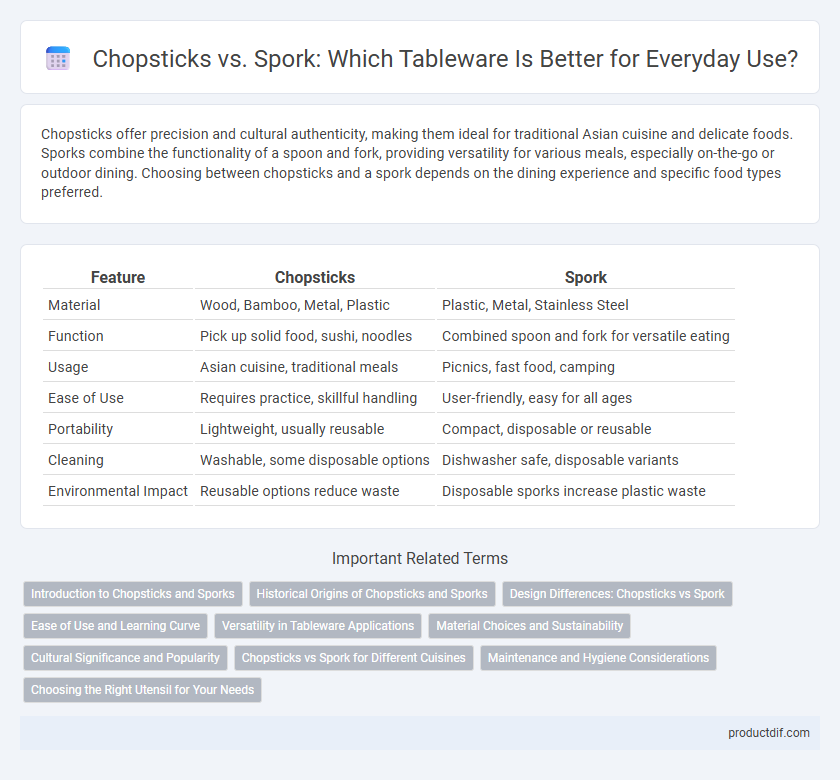Chopsticks offer precision and cultural authenticity, making them ideal for traditional Asian cuisine and delicate foods. Sporks combine the functionality of a spoon and fork, providing versatility for various meals, especially on-the-go or outdoor dining. Choosing between chopsticks and a spork depends on the dining experience and specific food types preferred.
Table of Comparison
| Feature | Chopsticks | Spork |
|---|---|---|
| Material | Wood, Bamboo, Metal, Plastic | Plastic, Metal, Stainless Steel |
| Function | Pick up solid food, sushi, noodles | Combined spoon and fork for versatile eating |
| Usage | Asian cuisine, traditional meals | Picnics, fast food, camping |
| Ease of Use | Requires practice, skillful handling | User-friendly, easy for all ages |
| Portability | Lightweight, usually reusable | Compact, disposable or reusable |
| Cleaning | Washable, some disposable options | Dishwasher safe, disposable variants |
| Environmental Impact | Reusable options reduce waste | Disposable sporks increase plastic waste |
Introduction to Chopsticks and Sporks
Chopsticks are traditional eating utensils commonly used in East Asian cultures, made from materials like wood, bamboo, metal, or plastic, and designed for picking up small portions of food with precision. Sporks combine the functionalities of a spoon and fork into a single utensil, often crafted from plastic or metal, making them versatile for scooping liquids and piercing solid foods. Both chopsticks and sporks serve specific dining purposes, reflecting cultural preferences and practical design for different types of cuisine.
Historical Origins of Chopsticks and Sporks
Chopsticks originated over 5,000 years ago in ancient China, initially used for cooking and later evolving into everyday eating utensils across East Asia. The spork, a modern hybrid of a spoon and fork, was patented in the early 20th century, designed to combine the functionalities of both utensils for convenience. While chopsticks have deep cultural significance in Asian dining traditions, sporks are primarily valued for their practicality in fast food and outdoor settings.
Design Differences: Chopsticks vs Spork
Chopsticks consist of two slender sticks made primarily from wood, bamboo, or metal, designed for precision grasping of food items. In contrast, a spork combines the functionality of a spoon and a fork into a single utensil, typically crafted from plastic or stainless steel, featuring a shallow bowl with short tines. The simplicity of chopsticks requires skilled dexterity, while the spork offers versatile usability for scooping, spearing, and cutting food in a more ergonomic form.
Ease of Use and Learning Curve
Chopsticks require practice and dexterity, often posing a steeper learning curve for beginners, while sporks offer intuitive use with their combined spoon and fork design. Sporks facilitate easy handling for a variety of foods, making them ideal for quick meals or outdoor dining. Chopsticks, however, provide precise control for picking up small or delicate items once mastered.
Versatility in Tableware Applications
Chopsticks offer precise control for picking up a variety of foods, excelling in Asian cuisine and delicate dishes like sushi or noodles. Sporks combine the functions of spoon and fork, allowing users to both scoop liquids and pierce solids, making them ideal for casual dining, camping, and mixed meals. Versatility in tableware applications depends on the specific eating context, with chopsticks favoring traditional, cultural meals and sporks providing multifunctional convenience.
Material Choices and Sustainability
Chopsticks are traditionally crafted from bamboo or wood, which are renewable and biodegradable materials offering sustainable options in tableware. Sporks are often made from stainless steel or durable plastics; stainless steel provides long-lasting reuse potential, while plastic versions raise environmental concerns due to non-biodegradability and production emissions. Choosing chopsticks made from responsibly sourced bamboo or stainless steel sporks supports eco-friendly dining practices by minimizing waste and promoting material sustainability.
Cultural Significance and Popularity
Chopsticks hold deep cultural significance in East Asian countries like China, Japan, and Korea, symbolizing tradition and etiquette in daily dining practices. The spork, a hybrid utensil combining a spoon and fork, emerged primarily in Western cultures as a practical solution for fast food and outdoor eating, gaining popularity for its convenience. While chopsticks remain integral to heritage and culinary identity, sporks are favored in casual, on-the-go meals, reflecting differing cultural dining priorities and habits.
Chopsticks vs Spork for Different Cuisines
Chopsticks are essential utensils in East Asian cuisines, specifically used for dishes like sushi, ramen, and stir-fries, allowing precise control when picking up small or slippery foods. The spork, a hybrid of spoon and fork, suits Western and casual dining settings, particularly for salads, soups, and fast foods, combining functionality and convenience. Each utensil complements its respective cuisine's dining style and food texture, enhancing the overall eating experience.
Maintenance and Hygiene Considerations
Chopsticks, often made from wood or bamboo, require thorough drying after washing to prevent mold growth and maintain hygiene, while metal or plastic chopsticks are easier to sanitize and more durable. Sporks, usually crafted from stainless steel or BPA-free plastic, offer straightforward cleaning through dishwashers and resist bacteria buildup due to smoother surfaces. Proper maintenance of both utensils involves regular inspection for cracks or wear to ensure hygiene and prolong usability.
Choosing the Right Utensil for Your Needs
Choosing the right utensil depends on the meal and cultural context, with chopsticks excelling for Asian cuisine and sporks offering versatility for casual or outdoor dining. Chopsticks provide precise control for picking up delicate or small food items, while sporks combine the functionality of a spoon and fork, making them ideal for soups, salads, and mixed dishes. Consider the type of food, convenience, and dining style to select the utensil that enhances your eating experience.
Chopsticks vs Spork Infographic

 productdif.com
productdif.com